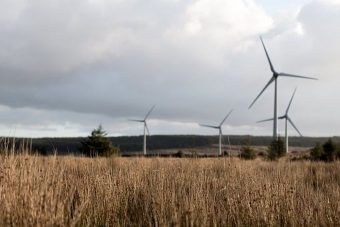
The 2009 Green Energy Act gave little thought to the transformation that wind farms bring to rural communities — problems that even revisions to the act “will only partially address,” writes a group headed by Stewart Fast. Fast personally favours wind energy, “but only if it’s done right.”
In Ontario, he says, much of it wasn’t.
He studies energy and environment issues at U of O’s Institute for Science, Society and Policy, and led a study group including industry and anti-wind members. Their paper, Lessons learned from Ontario wind energy disputes, has been published in the journal Nature Energy.
The Liberals’ Green Energy Act came in quickly, the geographer said in an interview. It brought new investment, “but those discussions about how a place will change because of this new project happened late in the process … There was a sense that the quicker you got in your proposal for the FIT contract to the government, the better chance you had.”
The FIT, or Feed-In Tariff, gave premium prices for solar and wind energy.
“It was a gold rush, basically,” said Fast. And since those involved kept details secret to avoid giving their competitors an edge, residents didn’t know what their neighbours were planning.
“That is really the worst way to go about something that you know is going to have a big impact” on landscape and people, he said. Ontario took little account of heritage, landscapes and “place-attachment,” the sense we have of being anchored somewhere, the group writes.
“As it currently stands, Ontario’s renewable energy policy framework ignores these complex questions of identity and the question of whether or not turbines will fit into communities,” the study says.
Fast said there’s a “jarring change that can happen once turbines come up — that is something that is important.”
As well, some residents near wind farms worry about health impacts from vibration and sounds that are too low for human ears to hear. Fast says Ontario brushed off these concerns without enough information, assuming there is no health impact unless proven otherwise rather than “taking a precautionary approach.”
Other issues he raises:
Premier Dalton McGuinty announced at the start that renewable energy would not be blocked by NIMBY protests, effectively labelling opposition as “ignorant, kind of self-interested NIMBY-ism. That’s a mistake right off the top.”
“There was lip-service paid to the importance of having community ownership.” But the reality didn’t give much support to community projects.
Wind opponents have often complained that most wind farms are run by industries from outside their communities.
Developers preferred one-on-one talks with residents to avoid the protests that can happen at big meetings. But rural people saw this as a “divide-and-conquer” method.
The Act removes municipal zoning controls over renewable projects.
In Ottawa, one wind opponent said the disputes over turbines “have pitted neighbour against neighbour.
“Just in terms of the fabric of the community (it is) ripping people apart,” said Jane Wilson, who chairs Ottawa Wind Concerns. “Even families are not speaking. People have lost complete faith in their government … People had no say whatever in what happened in their community.”
Fast’s group concludes that more transparent approaches would make some wind proposals more acceptable, but it isn’t optimistic. The authors end the study by saying: “Nonetheless, many of our recommendations will unfortunately remain unaddressed, without further consideration or assessment of the lessons that could be learned.”
Ontario now has 5,700 megawatts of wind capacity, though turbines don’t run at top speed all the time. Ontario’s total capacity from all sources is 35,221 MW.
Source : ottawacitizen.com


